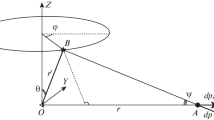Abstract
The conventional interpretation of the Hubble effect as a Doppler effect, based upon the concept of an expanding universe or based upon the idea of a continuously increasing radius of curvature of space, leads to some difficulties. It seems possible to avoid these difficulties by ascribing the redshift of light coming from remote galaxies to the fact that the non-Euclidean structure of the universe gets more and more important as observation extends to regions extremely distant from the point of observation. Hubble's phenomenon thus seems based upon the structure of space and time as judged from the point of observation; this means that it appears as a consequence of the “geometria intrinsica” of the universe.
Similar content being viewed by others
References
M. v. Laue,Die Relativitätstheorie, II (Vieweg, Braunschweig, 1965).
S. Lie,Theorie der Transformationsgruppen, III (Leipzig, 1930).
E. Hardtwig,Ann. Physik 2, 272 (1948).
V. Ambarzumian,J. Brit. Astron. Assoc. 73, 235 (1963)
Author information
Authors and Affiliations
Rights and permissions
About this article
Cite this article
Konitz, H. A geometric aspect of Hubble's phenomenon. Found Phys 5, 185–191 (1975). https://doi.org/10.1007/BF01100326
Received:
Issue Date:
DOI: https://doi.org/10.1007/BF01100326




